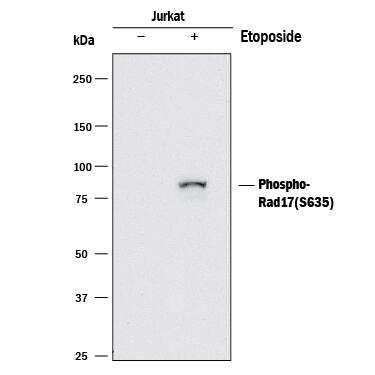Human Phospho-Rad17 (S635) Antibody
R&D Systems, part of Bio-Techne | Catalog # MAB1374

Key Product Details
Validated by
Species Reactivity
Applications
Label
Antibody Source
Product Specifications
Immunogen
Accession # O75943
Specificity
Clonality
Host
Isotype
Scientific Data Images for Human Phospho-Rad17 (S635) Antibody
Detection of Human Phospho-Rad17 (S635) by Western Blot.
Western blot shows lysates of Jurkat human acute T cell leukemia cell line untreated (-) or treated (+) with 25 µM Etoposide for 6 hours. PVDF membrane was probed with 0.5 µg/mL of Rabbit Anti-Human Phospho-Rad17 (S635) Polyclonal Antibody (Catalog # MAB1374) followed by HRP-conjugated Anti-Rabbit IgG Secondary Antibody (Catalog # HAF008). A specific band was detected for Rad17 at approximately 75 kDa (as indicated). This experiment was conducted under reducing conditions and using Immunoblot Buffer Group 1.Applications for Human Phospho-Rad17 (S635) Antibody
Western Blot
Sample: Jurkat human acute T cell leukemia cell line treated with Etoposide
Formulation, Preparation, and Storage
Purification
Reconstitution
Formulation
Shipping
Stability & Storage
- 12 months from date of receipt, -20 to -70 °C as supplied.
- 1 month, 2 to 8 °C under sterile conditions after reconstitution.
- 6 months, -20 to -70 °C under sterile conditions after reconstitution.
Background: Rad17
The DNA damage response activates cell cycle checkpoints to allow time for DNA repair and ensure the fidelity of each cell cycle. The Rad genes were first identified in yeast as genes required for the DNA damage response. Human Rad17 bears homology to the replication factor C (RFC) proteins and interacts with the Rad9/Rad1/Hus1 complex in cells exposed to multiple types of genotoxic stress, including ionizing radiation (IR) and ultraviolet light (UV).
Alternate Names
Gene Symbol
UniProt
Additional Rad17 Products
Product Documents for Human Phospho-Rad17 (S635) Antibody
Product Specific Notices for Human Phospho-Rad17 (S635) Antibody
* Contains <0.1% Sodium Azide, which is not hazardous at this concentration according to GHS classifications. Refer to SDS for additional information and handling instructions.
For research use only
